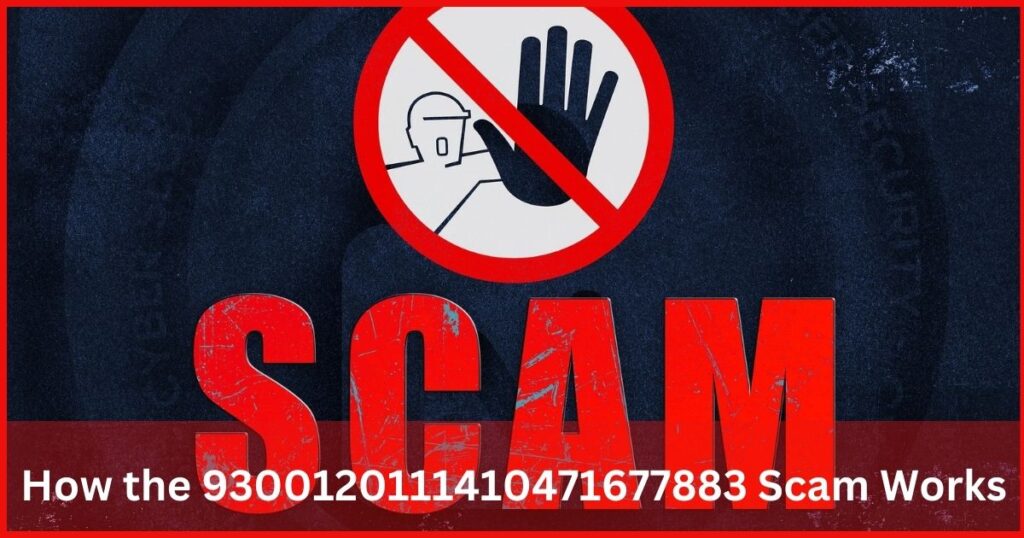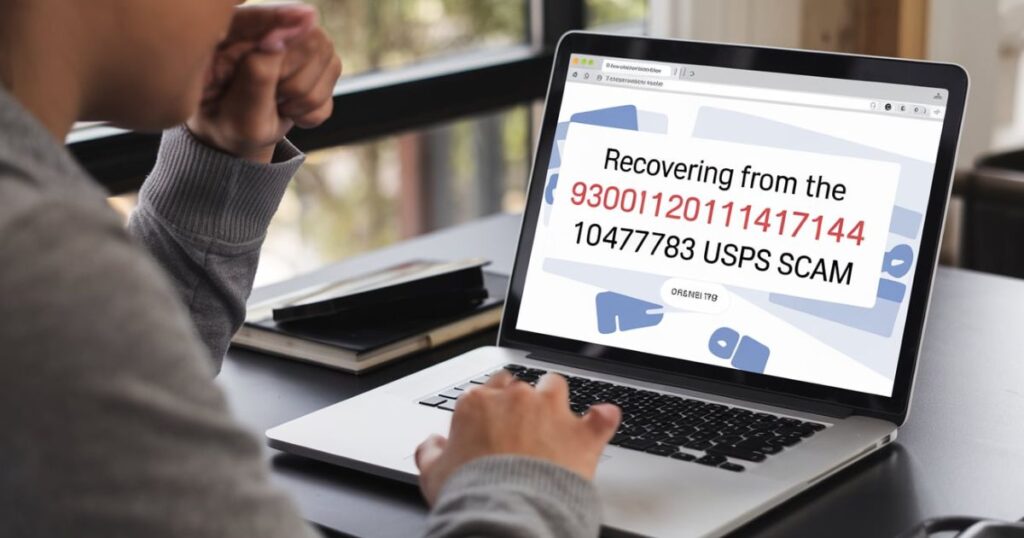In recent months, a rather alarming trend has emerged scammers are targeting online buyers in the USA with a focus on a specific USPS tracking number: 9300120111410471677883. This particular number is being used in a phishing scam that aims to trick people by impersonating legitimate USPS messages.
The 9300120111410471677883 USPS tracking scam is a type of copycat phishing that uses fake text messages and websites to steal personal and financial data from unsuspecting victims. If you receive a message claiming there’s an issue with a package delivery and includes this tracking number, it’s crucial to be cautious.
This scam is part of a growing problem, as fraudsters continue to find new ways to exploit people’s trust in the USPS brand. Understanding how the 9300120111410471677883 scam works and taking proactive steps to protect yourself is essential to avoid falling victim to this and similar phishing attempts.
What is the 9300120111410471677883 USPS Scam?
The 9300120111410471677883 USPS scam is a type of copycat phishing that uses fake text messages in the name of the USPS. These messages tell the recipient that there is a problem with the delivery of a package and contain a link to a fake USPS website.
The page is fraudulent, and its main purpose is to either get your personal or financial data or load malware into your computer. It’s crucial to be aware of this scam and take steps to safeguard yourself. By understanding how the 9300120111410471677883 USPS scam works, you can avoid falling victim to this and similar phishing scams.
How the 9300120111410471677883 Scam Works

The scam typically begins with an unsolicited contact, either via SMS or email. The message will claim there’s been an issue with the delivery of a package and provide a link to a website that appears to be the official USPS site. However, this website is nothing more than a facade – it’s a fake page designed to steal your personal or financial information, or even infect your device with malware.
The goal of the scammers is to obtain your sensitive data or introduce malicious software into your system. By clicking on the link or providing information on the fraudulent USPS website, you risk having your identifiers and financial information stolen or having malware installed on your device.
What Happens When You Click the Link?
When you click the link, you’re taken to a fake website that looks just like the real USPS site. It uses the same colors, logos, and layout to trick you into thinking it’s legit. The site will ask for your personal information, like your name, address, or even credit card details, under the pretense of fixing a delivery issue.
Once you enter your info, the scammers steal it. They may use it to take your money, open accounts in your name, or sell your details to other criminals. It’s all a trick designed to get you to hand over sensitive information without realizing it.
Is 9300120111410471677884 a Fake USPS Tracking Number?
Yes, the tracking number 9300120111410471677883 is a fake number used by scammers. It is not a legitimate USPS tracking number. The scammers use this fake number to make their messages and website seem more convincing, mimicking the real USPS communication.
It’s crucial to be aware that this tracking number is not associated with any genuine USPS shipment. By being vigilant and taking the necessary precautions, you can significantly reduce your risk. This will help you avoid falling prey to this and other similar fraudulent schemes. If you receive a message claiming there’s an issue with a delivery using this number, it’s most likely a phishing scam. These scams attempt to trick you.
Warning Signs of a Fake Tracking Number
Unexpected Messages: Be cautious if you receive a tracking number out of the blue, especially from a source you didn’t expect, as it could be a scam attempt.
Phishy Links: Watch out for links that look suspicious or lead to unfamiliar websites, as scammers often create fake pages that mimic real courier services.
Urgent Calls to Action: Scammers might pressure you to act quickly by claiming there’s a problem with your delivery, urging you to click a link or provide details immediately.
Poor Language Use: Be skeptical of messages with odd grammar or spelling mistakes, as these are common red flags in fraudulent communications.
Requests for Sensitive Info: Legitimate companies won’t ask for personal or financial information through unsolicited messages, so be wary of any such requests.
Read More : Unlocking the Power of 127.0.0.1:62893: Your Gateway to Secure and Efficient Local Development
What the Scammers Do with Your Info?
Scammers use your personal info in harmful ways. They might sell it to other criminals who use it for fraud. With your details, scammers can steal your identity to open credit cards or loans in your name, causing damage to your finances.
They could also drain your bank account if they have your financial info. Some scammers may send more fake messages to trick you again or even target your friends and family. It’s important to stay cautious and protect your personal information.
How to Protect Yourself
To avoid falling victim to this scam, it’s crucial to take the following precautions:
- Verify the URLs: Always check the URLs of any websites you’re directed to, especially if it’s through a message you received unexpectedly. Legitimate USPS-related websites will have the domain USPS.com.
- Avoid Clicking on Links: In the messages that are received from 9300120111410471677883 unexpectedly, it’s advised that you should not try to follow or click on links in the messages.
- Watch for Red Flags: Be wary of any messages that display red flags, such as poor grammar, a sense of urgency, or requests for your personal information.
- Report Suspicious Messages: If you receive a suspicious message, report it to USPS. You can also report it to the Federal Trade Commission (FTC) at reportfraud.ftc.gov.
- Use Security Software: Ensure your device has up-to-date security software to protect against malware and phishing attacks.
Steps to Take If You’ve Been Scammed
If you’ve already fallen victim to this scam and provided your personal or financial information, take the following steps:
- Contact USPS: Report the scam to USPS about 9300120111410471677883 to assist them in combating the existence and occurrence of the scam.
- Monitor Your Accounts: Check your accounts from time to time for any transaction that seems shady.
- Run a Malware Scan: Utilize reliable security software to scan for and purge all malware.
- Change Your Passwords: Change passwords for profiles that may have been hacked.
- Notify Credit Bureaus: Consider reporting your identity to the major credit bureaus as stolen if you are a victim of identity theft.
Taking these actions can help mitigate the potential damage and protect your personal information and financial data.
Recovering from the 9300120111410471677883 USPS Scam

If you’ve fallen for the 9300120111410471677883 USPS scam, don’t worry there are steps you can take to protect yourself. Start by contacting your bank and credit card companies to let them know what happened. They can help monitor your accounts for any unusual activity. You should also request a fraud alert with a credit bureau to prevent anyone from opening new accounts in your name.
Keep an eye on your credit reports and look for anything suspicious. If you spot something, report it immediately. It might take time to fix everything, but acting quickly will minimize the damage. Remember, you’re not alone, and there are resources available to help you recover from identity theft or fraud.
Preventive Measures
To protect yourself from future scams, consider these tips:
- Be Cautious with Personal Information: Never pass any information over the internet that you are not certain is received by the correct person.
- Verify Contact Details: Always confirm the contact information and any demands for payments through more official means.
- Educate Yourself: Stay informed about the latest phishing scams and fraud tactics so you can be better prepared.
Conclusion
The 9300120111410471677883 USPS tracking scam is a serious threat that can have devastating consequences for its victims. By being vigilant and taking the necessary precautions, you can significantly reduce your risk. This will help you avoid falling prey to this and other similar fraudulent schemes.
Remember, staying informed and taking proactive steps to protect yourself is crucial in today’s digital landscape. Don’t let the 9300120111410471677883 scam catch you off guard. Stay alert, verify information, and report any suspicious activity to the appropriate authorities. Your diligence can make all the difference in safeguarding your personal and financial well-being.
FAQs About 9300120111410471677883
What is the USPS scam involving tracking number 9300120111410471677883?
The scam involves fraudsters using a fake USPS tracking number to trick people into visiting a fraudulent website. Once they arrive, the scammers ask them to make a payment for a supposed failed delivery.
How can I identify if a message about a USPS delivery is a scam?
Look for red flags such as unsolicited messages, suspicious links, urgent demands for payment, and poor grammar. Verify the tracking number directly on the official USPS website rather than following the links in the message.
What should I do if I have provided my information to these scammers?
Immediately contact your bank to report the fraudulent activity and monitor your accounts for unauthorized transactions. You should also report the scam to the Federal Trade Commission (FTC) or the Internet Crime Complaint Center (IC3).
How can I protect myself from falling for similar scams?
Be cautious of unsolicited messages, verify tracking numbers through official channels, and use official websites by typing URLs directly into your browser. Educating yourself and others about such scams can also help prevent fraud.
Where can I find more information about this scam?
For more details, you can visit the Online Threat Alerts (OTA) website or similar platforms that track and report cyber threats. They provide updates and advice on how to recognize and avoid various scams.

With three years of experience in website development, I share the latest in technology on my blog, [TechTimy]. Join me for insights, trends, and updates in the tech world.


